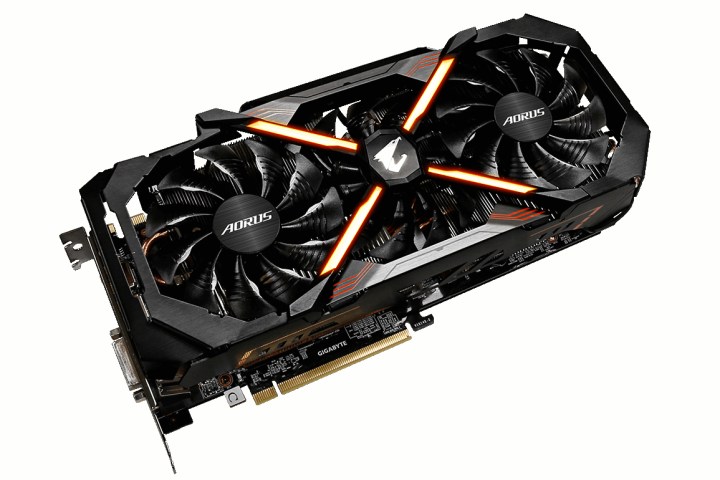
According to the specifications, the new card is overclocked right out of the box, offering two modes: Gaming and Overclocked. Here are the speeds for the graphics chip, the accompanying 8GB of on-board GDDR5X video memory, and also the reference GTX 1080 board just for comparison:
| GPU | Memory | |
| Nvidia’s Reference Base Speed: | 1,607MHz | 10,000MHz |
| Nvidia’s Reference Boost Speed: | 1,733MHz | N/A |
| Gaming Mode Base Speed: | 1,759MHz | 10,206MHz |
| Gaming Mode Boost Speed: | 1,898MHz | N/A |
| Overclocked Mode Base Speed: | 1,784MHz | 10,400MHz |
| Overclocked Mode Boost Speed: | 1,936MHz | N/A |
Now here are the remaining hardware specs of the new card:
| Architecture: | Pascal |
| Process technology: | 16nm |
| CUDA Cores: | 2,560 |
| Memory Bus: | 256-bit |
| Memory Bandwidth: | 320GB per second |
| Card Bus: | PCI Express 3.0 x16 |
| I/O Ports (Standard Mode): | 1x Dual-Link DVI-D 3x DisplayPort 1.4 1x HDMI 2.0b |
| I/O Ports (VR Mode): | 3x DisplayPort 1.4 3x HDMI 2.0b |
| Digital max resolution: | 7,680 x 4,320 @ 60Hz |
| Multi-view: | 4 |
| Recommended Power Supply: | 500 watts with two 8-pin external connectors |
According to Gigabyte, the GTX 1080 Aorus Xtreme Edition 8G outperforms the GTX 1080 Founder’s Edition and the GTX 980Ti reference card in three popular PC games. In a 64-bit Windows 7 test bed featuring an Intel i7-4790K processor, 16GB of system memory, and a 128GB SSD, the card was found to be 5 percent faster than the Founder’s Edition card in Overwatch, 10 percent faster in The Witcher 3: Wild Hunt, and 5 percent faster in Grand Theft Auto V.
Keeping the card cool under the overclocked conditions is the job of the company’s Windforce “stacked” cooling system, consisting of three 100mm fans residing over two large, finned heatsinks. Along with heat pipes, a large copper base plate resides on the front of the card to dissipate most of the heat away from the graphics chip and on-board memory via direct contact. Another large copper plate resides on the back to pull heat away from the back of the graphics chip.
On the lighting front, the card has an illuminated Aorus logo on the side, an illuminated logo on the back, and four stripes converging to the Aorus logo residing over the middle cooling fan. Configurable through Gigabyte’s free software, users can choose the right colors to match the system’s overall color scheme, and select from five lighting effects consisting of Cycling, Consistent, Flash, Dual Flash, and Breathing.
The card also includes an Aorus VR Link component, which Gigabyte boasts as the only output technology currently on the market that supports four display combinations for virtual reality without the need for an additional adapter. Aorus VR Link adds two HDMI ports to the side of the card, enabling the following video output configurations:
| Setup 1 | Setup 2 | Setup 3 | Setup 4 |
| VR Headset (HDMI) | VR Headset (HDMI) | VR Headset (HDMI) | VR Headset (HDMI) |
| DisplayPort | HDMI | HDMI | HDMI |
| DisplayPort | HDMI | DisplayPort | |
| DisplayPort | DisplayPort |
Right now, there’s no official word on availability and pricing, but the company is expected to launch the card in February for somewhere around $800 here in the United States. The card will come with a 4-year warranty that must be activated by registering the card online.


